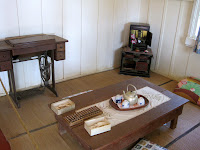

I would like to introduce Hawaii’s Plantation Village in my blog today. Many of us in Hawaii have roots that go back to the sugar plantations. My dad grew up in a plantation home in what was once referred to as Lower Village in Ewa. As a child growing up in Japan, I looked forward to summer and our trips back to Hawaii to visit my Baban (Grandmother) in Ewa. She lived in a plantation home, I think the same one that my dad grew up in along with his seven siblings. But there were certain things that I dreaded. I did not like the outhouse (bathroom outdoors) and the community furo (bath). But besides that, the house was wonderful, so laid back with a porch in the back and a huge mango tree. My Baban had a vegetable garden in the back of her home and she would use the vegetables to cook her delicious Okinawan/Hawaiian dishes.
I guess all of these memories came back to me on my visit to Hawaii’s Plantation Village in Waipahu a few months ago. I went with my two aunties who are both in their 80’s (they were raised in Baban’s plantation home) and my cousins. I was shocked when I saw the Okinawan home there because it was so much like Baban’s home. The outhouse and the place that we would wash clothes was eerily the same. The community bath house at the Plantation Village looked much nicer than the one I remember. All I can remember is how dark it was inside and the geckos. Was it really like that or did I imagine it?


Replica of outhouse at Hawaii's Plantation Village

Community furo (bath house)
Hawaii’s Plantation Village has so much history. It truly showcases the lifestyles of each ethnic group of plantation workers that emigrated to Hawaii to work in the sugar cane fields. This outdoor museum of furnished homes, other community structures, art, architecture, antiques and relics interprets the history of Hawaii’s multi-ethnic heritage.
The Village is operated by The Friends of Waipahu Cultural Garden Park, a non-profit educational organization. Their mission: “ensuring that the experiences, lifestyles, struggles, sacrifices, innovations and contributions of our plantation forebearers are known, acknowledged, and visible as the cornerstones of Hawaii’s successful multicultural society.” When I read their purpose, certain words really hit home. “Struggles and sacrifices,” I think of my grandparents and how many hardships they went through to raise their family of eight children. I think about Baban and how she had to raise the kids by herself after Grandpa died when my dad was only nine years old, and about how my Uncle Ani-san had to quit school to work for the plantations to support the family. Then my Aunty H had to do the same. And those stories of struggles and sacrifices go on and on.


Historical background includes "picture bride" and the work clothes of the laborers
The other words I really like are “innovations and contributions” because then I think about how blessed we are in Hawaii to have such a variety of food. There are so many local treats that we have today that stem from the old plantation days. Saimin was created by the joint efforts of each of the original ethnic groups that labored in our sugar cane and pineapple plantations. It is a dish that represents the Chinese, Filipino, Japanese, Korean, Hawaiian and Portuguese laborers.
In order to save money, communal cooking was a common practice. Every family would donate an ingredient that they were able to spare. The Japanese family might share their kamaboko, the Chinese their noodles, green onions from the Filipinos, bok choy (cabbage) from the Korean family, leftover sausage from the Portuguese and some chicken or eggs from the Hawaiians. And that is how saimin came to be. How's that for innovation and contribution?
The plantation workers assimilated into Hawaii’s society but they never forgot their roots, their own culture and traditions. And because of this Hawaii continues to have a multi-ethnic society that we are all very proud of.
So if you are interested in learning more about the old plantation days and how the folks lived back then, Hawaii’s Plantation Village is a must. Knowledgeable docents will take you on a guided tour. Visit and experience the warm and welcoming atmosphere that was part of Hawaii in the early 1900s.


Chinese Society Building (1909) and a Chinese kitchen


Portuguese kitchen and home

Portuguese forno (oven used to bake bread and other delicacies)


Puerto Rican kitchen

Puerto Rican bedroom, young girl ready for church


All plantation homes had washing area, slop pail and wash tub.


Barber shop and Wakamiya Inari Shrine (1914)


Plantation store


Japanese kitchens


Japanese living rooms

Japanese furo (bath)


Japanese bedrooms (one with bed and the other with futon)
The ichimenkyo (mirror stand) was probably brought over from Japan by the bride to be used to fix her hair and put her make up on.


Okinawan kitchen


Okinawan living room, picture of ancestors


Korean kitchen, living room

Korean bedroom
Hawaii's Plantation Village
HonoluluFestival







No comments:
Post a Comment